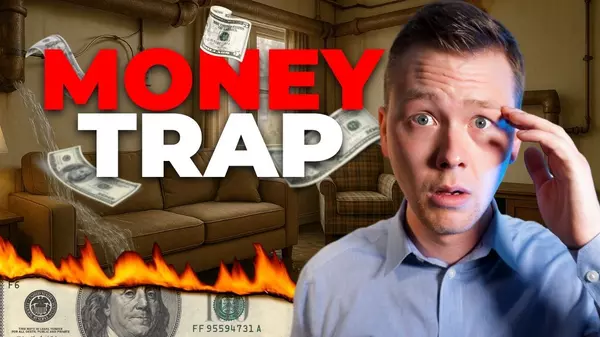Why a Deceleration in Home Pricing Does Not Mean Depreciation in Home Values

It's been a little more than a year since the market started decelerating. In this time, home prices have seen a slowdown, but there has yet to be any depreciation in home values. This is according to new data from CoreLogic which suggests that "the rate of annual home-price appreciation continued to slow in November, although it remained positive." So what does this mean for homeowners and those considering purchasing a property?
The definition of depreciation
Depreciation in real estate is an important and often misunderstood concept. In simple terms, it refers to how a property's value decreases over time due to wear and tear, obsolescence, or any other form of deterioration. For instance, a building constructed 30 years ago will have depreciated more than similar one built five years ago. To accurately measure the depreciation in a piece of property, investors should consider factors such as age, condition, location, and market trends. Depreciation can provide investors with an advantage come tax season when taken into consideration by appropriate deductions from income taxes. It's wise for investors to understand what propery depreciation means and its implications on their investments.
The difference between depreciation in pricing vs depreciation in home value
Depreciation in pricing and depreciation in home value are very different concepts, though they are frequently confused by buyers and sellers. Depreciation in pricing involves the decrease of a product or service's retail price due to time or market competition. For example, if an airline ticket is purchased at full fare one month before a trip, but the same ticket costs significantly less when purchased just two weeks later, this is an example of depreciation in pricing. On the other hand, depreciation in home value results from wear and tear on the house and/or property that cannot be repaired without significant investments. For instance, someone who purchases a home with outdated fixtures may pay a lower price up front due to its reduced market value; however, they will likely have to pay thousands of dollars more over time as they update these aspects of their home. Understanding the nuances between these two types of depreciation can save homeowners many expensive mistakes.
Why a deceleration in home pricing does not mean depreciation in home values
Home pricing and values are not the same thing, despite what some might think. While a fall in home pricing may give people the impression that their home's value is depreciating, this is not necessarily true. Home value is largely determined by factors like overall market conditions, location, and housing trends; decreased pricing can actually be beneficial if these factors have led prices to increase too high. Furthermore, prestige and sentimentality often lead to a discrepancy between cost and actual value - meaning a decrease in pricing may still be counteracted by an increase in perceived value. All in all, regardless of circumstances, fluctuating prices do not always equate to depreciation of a home's real worth.
Factors that influence home values
The value of a home is determined by a variety of factors, both internal and external to the property itself. Internal factors such as remodeling recognition, cleanliness and curb appeal are easy to ascertain by examining the home. External factors, like nearby school district reputation or location in relation to transportation hubs such as airports, can have a significant effect on property values. Additionally, market conditions heavily influence the value of real estate – supply and demand trends play an integral role in determining the sale prices of houses. Lastly, economic data can tell us about the overall health of an area which directly affects the price of housing within it. One thing is certain: many different conditions must be taken into account when evaluating a home's worth.
How to protect your home's value
One of the best ways to protect your home’s value is to stay informed about property values and trends in your neighborhood. It’s important to be aware of what a reasonable price for your part of town, so when it comes time to sell or take out additional financing, you can be sure that you are getting a fair deal. Other easy steps that can help maintain the value of your home include making improvements with good quality materials that will add lasting appeal, and regular maintenance on existing features like the roof, windows and landscaping. Keeping your home's appearance looking up-to-date is key to attracting prospective buyers at a higher value – and ultimately paying off with a longer lasting investment.
Depreciation is a complex issue in real estate, but it's important to understand the difference between depreciation in home pricing and home value. A deceleration in home pricing does not necessarily mean that there is depreciation in home values. Home values are influenced by many factors, including the economy, interest rates, inflation, market conditions, and more. You can protect your home's value by monitoring these trends and taking action to keep your property well-maintained. If you have any questions about how to protect your investment or would like help understanding depreciation, please don't hesitate to contact us. We're here to help!
Categories
- All Blogs (819)
- Airway Heights (4)
- Audubon/Downriver (4)
- Balboa/South Indian Trail (5)
- Bemiss (3)
- Browne's Addition (3)
- Buying Your Home in Spokane (191)
- Cheney (3)
- Chief Garry Park (3)
- Cliff-Cannon (3)
- Colbert (1)
- Comstock (4)
- Dishman (3)
- Driving Tours (1)
- East Central (3)
- Emerson/Garfield (3)
- Five Mile Prairie (5)
- Grandview/Thorpe (3)
- Greenacres (3)
- Hillyard (3)
- Home Improvement (8)
- Home Prices (5)
- Housing Inventory (6)
- Housing Market (131)
- Instagram Videos (2)
- Interest Rates (24)
- Job Market in Spokane (3)
- Know Spokane (518)
- Latah Valley (5)
- Liberty Lake (8)
- Lincoln Heights (4)
- Logan (3)
- Manito-Cannon Hill (3)
- Medical Lake (4)
- Minnehaha (3)
- Moran Prairie (3)
- Mortgage (26)
- Moving out of Spokane (3)
- Moving to Spokane (141)
- Nevada/Lidgerwood (3)
- New Construction Opportunities (3)
- North Hill (3)
- North Indian Trail (4)
- Northwest (3)
- Opportunity (3)
- Peaceful Valley (3)
- Riverside (3)
- Rockwood (4)
- Selling Your Spokane Home (149)
- Shiloh Hills (3)
- Southgate (3)
- Spokane Events (372)
- Spokane Neighborhoods (51)
- Spokane Restaurants/Food Places (24)
- Spokane Schools (12)
- Spokane Valley (14)
- Suncrest (1)
- Things to Do in Spokane (385)
- Veradale (3)
- West Central (3)
- West Hills (3)
- Whitman (3)
- Youtube Videos (49)
Recent Posts











